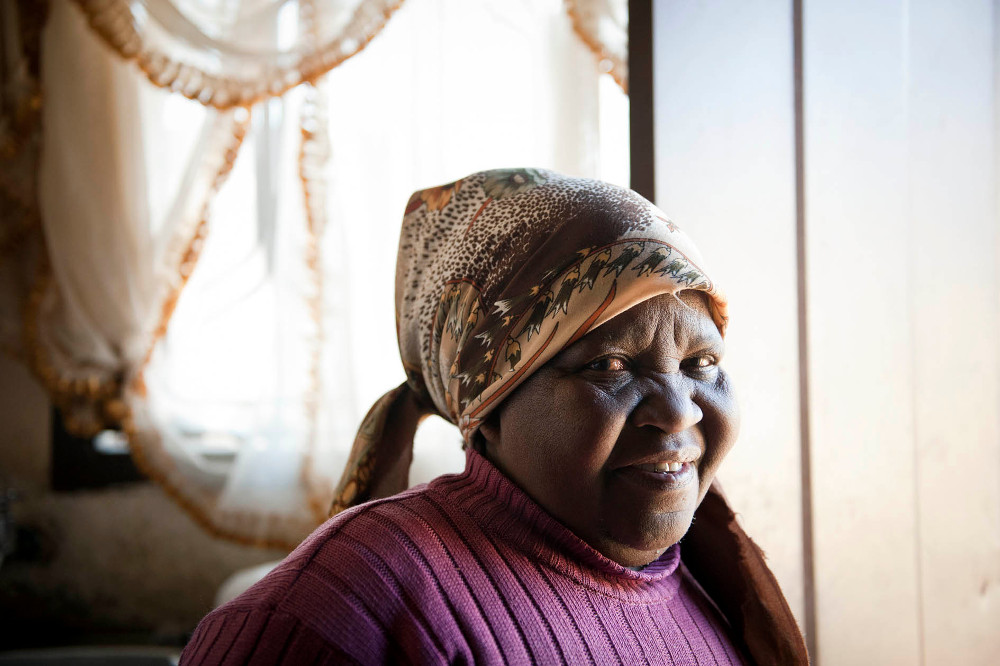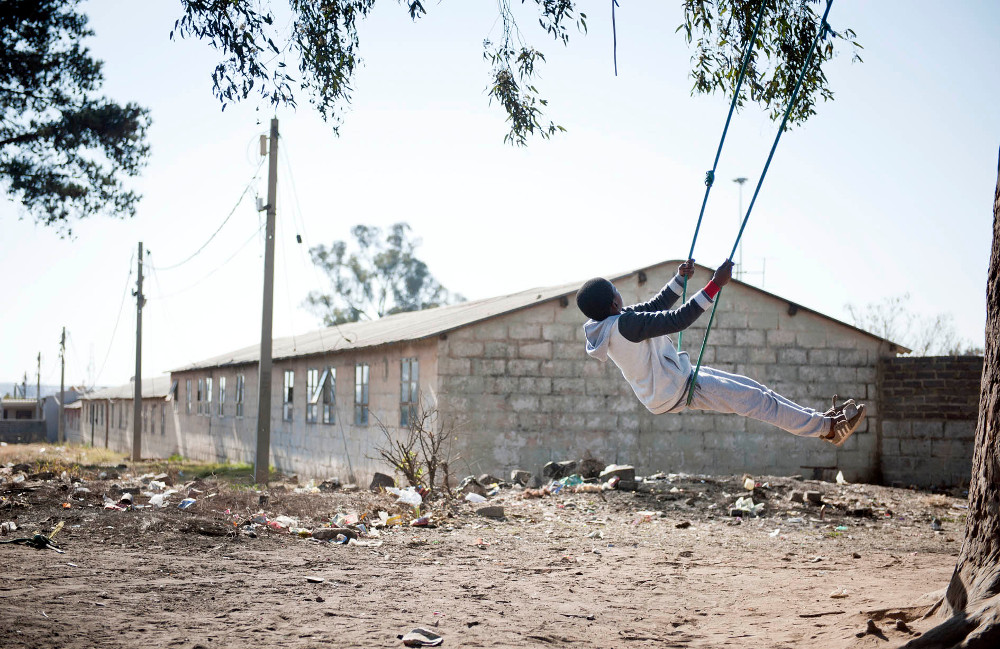Residents say the black smoke when ArcelorMittal burns at night is the worst as it 'comes down everywhere'.
“I loved sport, especially the freedom of just running. Now I can’t even walk to the end of the street without breathing heavily.” That freedom was important to Florence Molete because she was born in an age where black workers had little of it.
The wide streets of her Boipatong home, in southern Gauteng, were patrolled by apartheid police.
“If you worked for the factories and said nothing you were fine, but we were [she smiles] … problematic.” Tucking her hands inside the pink blanket wrapped around her 1.2m- tall frame, the 60-year-old says the struggle now is against the constant air pollution. “Staying here makes you sick and we must change that.”
The principal causes of her problems rise into the sky a few hundred metres from her home – the smokestacks of ArcelorMittal’s Vanderbijlpark plant.
Built in the 1940s, the plant turns raw materials into metal sheets used by the building industry. It is the largest steel mill in sub-Saharan Africa and made the company more than R200-million last year.
Clasping her hands together, Molete says the factory has been there her whole life. “We have always had to live with the smoke from Mittal. You won’t find many old people like me still walking around.”
Worse at night
The worst smoke comes at night, when the asthmatic wakes up with a heavy chest, unable to breathe. “You open the door to try to get fresh air and there is just this smoke outside. You cannot escape.”
Her granddaughter, 30-year-old Semakaleng Molete, stops sweeping the dust from her gate to join the conversation. “We suffer because of that factory. It does what it wants and nobody is fighting for us.”
Semakaleng is leaving next year to study teaching at the University of Potchefstroom. “I want to teach children accounting.”

Boipatong resident Florence Molete is an asthmatic, having lived in ArcelorMittal’s shadow all her life. (Photos: Madelene Cronjé, M&G)
Her high school teacher ensured that she got distinctions, but after he died the grades at the local school dropped. She now gives extra lessons to pupils. The muscles on her face relax into a slight smile when she talks about her future plans. But the brief flare dulls as she turns to talking about her four-year-old son. “Already he cannot run as fast as the other children. If he tries to chase them, he just coughs.” He is on medicine to ease his chest pains, which is prescribed by the local clinic, but it runs out before the end of each month and she has to buy more.
“If I cannot afford the medication, he has such bad attacks that he must go to hospital.” There, her son has to be put on a machine to help him breathe.
Unanswered questions
ArcelorMittal has consistently maintained that it is not responsible for health problems in the Boipatong community. Community members tell the Mail & Guardian that while there were a few public meetings held in the past, their questions regarding the link between emissions from the plant and health problems were never answered.
ArcelorMittal did not respond in any detail to questions about the health impacts of their operations. It told the M&G that it has “made a concerted effort to hold regular meetings”.
In its annual report the company says it has taken significant steps towards improving its environmental footprint. This includes hundreds of millions of Rands being spent on various projects around the Vanderbijlpark plant. These have lowered the emissions of gases such as sulphur dioxide, and the greenhouse gas, carbon dioxide. Citing problems around having inherited old plant equipment, the company says progress was accelerated by new air quality legislation. The company has already rehabilitated several waste dumps and water treatment areas at the plant.
Boipatong was established in 1955 to house a labour pool convenient for the surrounding industry. Apartheid South Africa placed its heavy industry here – the Iron and Steel Corporation (Iscor) as well as Sasol and Eskom. Environmental costs were externalised and borne by the residents.
Different kinds of smoke
On a cold winter’s morning there is little wind and a grey smog covers the area around Vanderbijlpark. Everything is dull – either cement grey or the dead yellow of winter grass. Residents know the different kinds of smoke they have to live with intimately. While talking, people link them, and the constantly shifting smells, to different parts of the sprawling Mittal plant.
“The worst is the black smoke when they burn at night. It comes down everywhere.” The man speaking does not want to be identified – work here is scarce. Holding a section of his rusted fence, he looks at the plant a few hundred metres away from his RDP house. “Everyone here is sick. That is not normal.”

Many children growing up in the area have health problems.
His section of homes is almost two decades old, built in the empty space between Boipatong and the plant. Mittal’s three-metre-high grey walls form a bulwark against the fires that eat up the winter grass and a sea of plastic bags. A constant drone of heavy machinery and hissing steam is punctuated by the sharp toot of trains coming into the factory.
Like his wife, he grew up in Boipatong. She remembers playing in the fields next to the plant as a child. Speaking in Afrikaans and Sesotho and rubbing her hand on her chest for emphasis, she says she has frequent chest pains but cannot afford surgery.
“Mittal is the problem. But nobody will tell us for sure that they are making us sick, so what can we do?”
Environment ‘master plan’
ArcelorMittal took over the plant in a 2003 acquisition and says it has done substantial work to improve its environmental footprint. Much of this was based on a 2002 environment “master plan” outsourced by the company.
Local nongovernmental organisation Vaal Environmental Justice Alliance has spent more than a decade trying to get access to this report. Mittal rejected a Promotion of Access to Information Act request for it, and fought all the way to the Supreme Court of Appeal against its release. It lost this fight last November. The documents were released to the public this week.
The plan sets out areas of concern at the Vanderbijlpark plant – such as the leaking of old storage dams and the high sulphur emissions. But it was commissioned at a time when environmental legislation drafted in the 1960s was still in force.
Several new laws have been enacted, including a substantial overhaul of air quality legislation. Mittal is one of the large polluters that asked for, and got, a five-year postponement in complying with this law.
“We have this great new legislation which should be forcing companies to lower their emissions, but in practice there is little to ensure they do,” says Robyn Hugo. An attorney at the Centre for Environmental Rights, she worked on the case against Mittal.
“Large companies have operated on the basis of cutting costs by choosing cheaper technology and relying on people to pick up those costs.”
When anyone tries to change this relationship, she says, they fight back in any way that they can.
“This is a case of having to force companies to pay for the damage they do to the environment, and to the communities which host them.”
Green Scorpion inspection
Some action has been taken. In 2007 the Green Scorpions, the enforcement arm of the environment department, inspected the Vanderbijlpark plant and found “serious environmental problems”.
The unit discovered that the plant was releasing “excessive emissions of sulphur dioxide” – up to 60 tonnes a day. It also had “serious exceedances” of ammonia (15 times the legal limit) and dust particles (27 times the limit). An unlined hazardous waste dump, which has no permit for existing, was found to be leading to “significant contamination of groundwater”.
Bobby Peek, head of the nongovernmental group groundWork, says the work of civil society means companies are slowly being forced to do more for the environment and citizens.
“The status quo is that our companies emit all these pollutants and then react with shock when someone says that this makes people sick.” People are therefore left affected by industrial pollutants, but unable to move and unable to pay their exacerbated healthcare costs, he says.
“Business has a really ugly model in South Africa. We need to change that.”
Turning to walk down her dirt street, Molete smiles again, flashing a gold-plated tooth. “Maybe this will be good for us. People will know what is happening here and maybe someone important will care.”